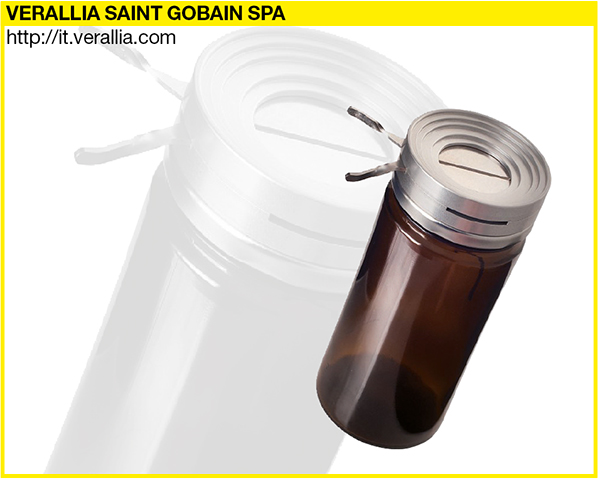Italian packaging Oscar 2015
The new features of the competition, its guiding principles, promotion, sponsors, and related events and of course ... the nominations. Hence spotlight on the protagonists of the contest - this year dedicated to technical innovation and technology - sponsored and organized by the Istituto Italiano Imballaggio and its Service Company Packaging Meeting.
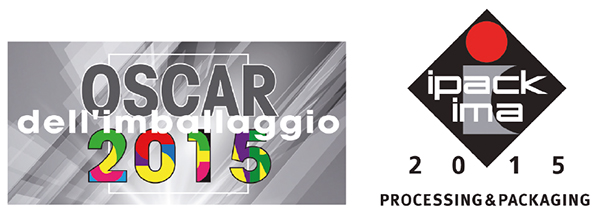
 “A snapshot of the evolution of research in the field of packaging and solutions to the problems of transport, protection, safety, but also of professional user or end consumer user- and handling friendliness”: This the concise definition of what has now for some time been a key event for the packaging sector.
“A snapshot of the evolution of research in the field of packaging and solutions to the problems of transport, protection, safety, but also of professional user or end consumer user- and handling friendliness”: This the concise definition of what has now for some time been a key event for the packaging sector.
The Italian Packaging Oscar 2015 this year introduces a new concept: The competition no longer has product categories and in fact, the Jury will consider which products have a degree of innovation and response to the real needs of the markets and the end user to make them packaging worthy of an Oscar, trying when possible to provide a comprehensive overview of the innovations for the different materials and for the different types of packaging, from primary to transport.
Increasingly in fact the new solutions respond to complex needs and are the result of a technological cross contamination, capable of interpreting in one and the same time the consumer’s demands for service and the demand for visibility, recognition and communication expressed by companies.
A less schematic competition hence, but with precise rules all the same, starting from the dominant principle of respect for technical and technological innovation. Not by chance Ipack-Ima, the large process and packaging fair scheduled in Milan May 19 to 23 next, is partner of the 2015 edition of the contest and will feature a permanent exhibition of the products entered.
And right at the fair, in Hall 14, May 20 at 16:30, will be held the award ceremony of the winners, as well as the conferment of special “Over All”, “Environment” (sponsored by CONAI) and “Quality Design” (sponsored by the Milan Polytechnic - School of Design) awards.
Oscar, a showcase of ideas
Thanks to the efforts made by the Istituto Italiano Imballaggio the Italian Packaging Oscar has in time become a valuable opportunity for promotion for all participants. Witness the repeat of the “fuorisalone”; (the acclaimed event held alongside the Milan Furniture Fair, which attracts the huge audience in the orbit of the B2B fair and creates a culture), successfully launched last year. From April 14 to 19, Spazio Solferino27 will host an exhibition of competing products, which will be open to visitors from roughly 2 pm to 10 pm.
During the Milan event encounters will also be organized on packaging design (“Packaging Design Stories”). On April 17, as part of “Brera Night”, the event open to the public “Innovation in packaging, food and drink” will take place (from roughly 6 pm to 10 pm), featuring a food design performance by Fabrizio Sansoni, drinks by Enrico Contro aka Frog and a DJ set by Terry Birardi, as well as a guided tour of the 2015 Italian Packaging Oscar exhibition.
The material published has been elaborated on the basis of the communiqués provided by the Istituto Italiano Imballaggio
Below, the products in the competition: characteristics, advantages and innovation.
CHEP ITALIA SRL - COOP ITALIA SCRL - CORTEPACK SPA Packaging & Display - DI MAURO OFFICINE GRAFICHE SPA - FILENI SIMAR SRL - GOGLIO SPA - GPP INDUSTRIE GAFICHE SRL - GRANAROLO SPA - GRIFAL SPA - ISI PLAST SPA - KRONES SRL - LIC PACKAGING SPA - PET ENGINEERING SRL - PLASTIPAK ITALIA HOLDING SRL - POLYMER LOGISTIC ITALY SRL - PUSTERLA 1880 SPA - RIVOIRA GAS SRL - SACCHITAL SPA - SANPELLEGRINO SPA - SEALED AIR SRL - SIPA SPA - TETRA PAK ITALIANA SRL - TUBETTIFICIO FAVIA SRL - VENCHIAREDO SPA - VERALLIA SAINT GOBAIN SPA
1 Fourth pallet
Chep launches a new generation pallet display. The global pooling leader proposes an innovative plastic pallet, with a high performance pallet display designed to optimize the supply chain and reduce CO2 emissions.
Chep’s “1/4 pallet” features stackability, stability and easy handling. The 600x400 mm recycled polypropylene format is designed to fasten quickly and securely to corrugated cardboard promotional displays with the REFA-certified exclusive Blue Click system. An effective weight reduction - approximately 1.9 kg, compared to the previous model’s 2.1 kg - and optimized stacking reduce the pallet’s bulk by 20%, at the same time enhancing load capacity on vehicles, with a CO2 emissions reduction of 15%.
The product complies with GS [1] standards and has been tested by independent entities such as the Fraunhofer Institute for Material Flow and Logistics. Chep’s innovative efforts have thus materialized in a pallet that enhances supply chain efficiency while optimizing performance during the collection and delivery phase.
[1] The GS or Geprüfte Sicherheit (“tested safety“) seal is a voluntary certification for technical apparatuses, indicating their compliance with applicable safety regulations in force in Germany, and, if available, Europe. Testing is performed by a state-approved independent entity.


2 ZeroTubo
Launched in late 2014, Coop ZeroTubo is the first toilet paper produced in Italy that, in the space traditionally occupied by the cardboard core, houses a removable mini roll. It is, in practice, a 500 tear maxi roll that contains an internal 50 tear mini roll, covered by a sheet of paper.
Once the six piece pack has been opened, it is thus possible to extract the mini roll and use it, for example, away from home, while the maxi roll can be used for usual domestic use.
This innovation was developed by Coop with the Sofidel Group, a leader in the paper industry that, in its Delicarta facilities and with a sizeable economic investment, has developed the technology in collaboration with the company Perini, a leading name in the manufaturing of tissue machines.
Coop ZeroTubo features as a measure to lighten packaging: the roll has in fact been recognized as such under Directive 2013/2/EU. Based on the assumed consumption, for the current year an estimated savings of 46 tons of cellulose are attained.
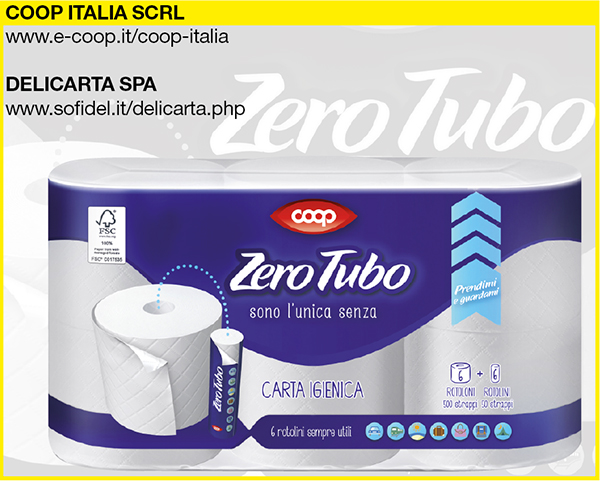

3 Box for horizontal bottles with built-in spacer
For 50 years, Cortepack has developed innovative solutions for packaging and the POP. The concern competes at the Packaging Oscars 2015 with a patented system: a box for 6 horizontal bottles with built-in spacer.
Below are the main strengths and advantages of the product.
- Easy assembly: packaging times reduced by 50%.
- Low environmental impact: the use of a single material enables production of a more “sustainable” and easy to recycle system.
- Customization: with its appealing look, the box respects all the image needs expressed by the user, who in such a way can create packaging systems ad hoc.
- Substantial costs reduction: by having the spacer built-in, Cortepack has created a single component, in such a way optimizing storage and handling operations.
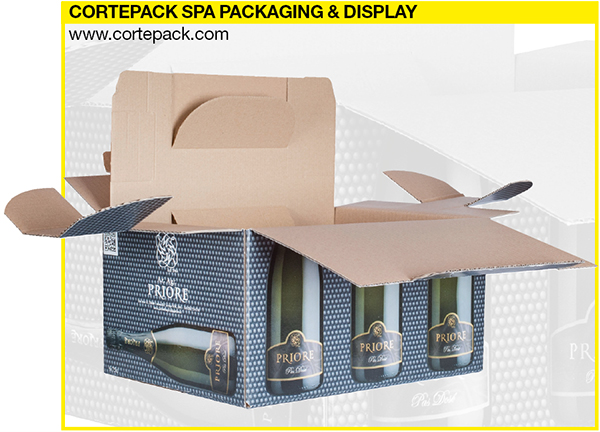

4 TwistPack
Destined for family format frozen foods, which more often than not need to be re-closed after the first opening, Di Mauro has created TwistPack, a reclosable flexible packaging solution.
The multilayer (PET 12my + AL 7my+PE 50my) is rotogravure printed, while lamination is performed using solvent-based adhesives.
The PET and AL layers are register laminated in order to facilitate separation at the top of the packaging, enabling the AL/PE complex to be folded, mechanically reclosing the packaging.
The closure is then guaranteed in any temperature or humidity conditions, and can be re-opened many times (whereas adhesives and labels can be worn down by refrigeration, losing efficacy over time).
More technological advantages of TwistPack:
- the integrated reclosure system means the consumer doesn’t have to resort to other devices (twine, rubber bands or clothes pins) to prevent accidental spills or leakage,
- the system is processed as a normal laminate, and thus requires no extra investment on packaging lines.
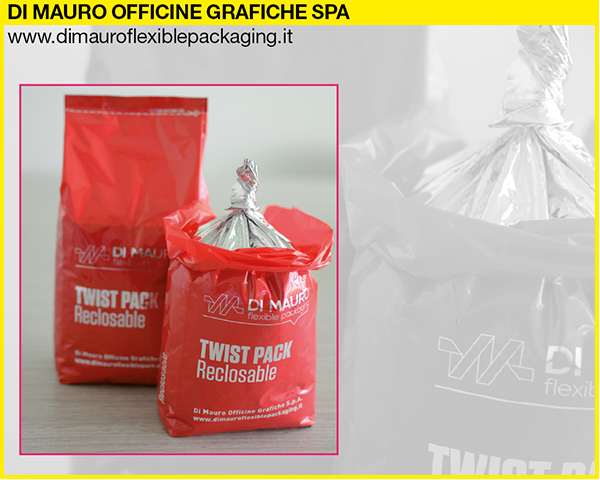

5 “eBox” container for meat
On the market since 1970, the Fileni Group*, third largest producer in the poultry and rabbit sector and the first in Italy for organic poultry, has always invested in technological innovation to improve the sustainability of their products. On the occasion of the Italian Packaging Oscar 2015, the company presents a new transport container for meat, capable of doubling the capacity compared to the previous version - from 3.5 kg to 7 kg - not only with the same external dimensions, but also with a significant reduction of the material used, compared with an alternative system to the automatic production process: eBox infact weighs 20% less compared to the solution that it will replace.
Meaning that, for an annual requirement of 12 Mil pieces, numerous advantages, both quantitative and qualitative, are attained:
- saving of 720 tons of paper;
- reduction the number of trucks used in the supply chain (464);
- reduction of 196 tons of CO2 emissions, considering the entire transport chain, from mill to market;
- reduction of 5.000 kg of hot melt in the assembly of the container.
This technological innovation, as well as generate a saving of EUR 270,000/year for the group Fileni, fully confirms the concern’s culture of excellence and respect for the environment.
* The mission of the Fileni group is to become dominant white meat brand in the well-being and gastronomy market. With an annual turnover of 325 million euros, 6 facilities and 1,755 employees, the company aims via trademarks Sempre Domenica and Club dei Galli, to consolidate its presence in the Large Retail, Normal Trade and Food Service sales channels.


6 Gtea proget
Goglio presents it as “the most active packaging ally”: GTea is an adhesive made from green tea extract which, harnessing the natural antiradical properties of catechins, acts on the oxidation process which foods packaged in flexible packaging undergo, enhancing their shelf life and organoleptic properties.
Resulting from the Safemtech research project developed with the University of Zaragoza and support from the European Union, with this “100% green” active packaging solution, Goglio proposes an ethical innovation that respects the environment: the wide availability of green tea, along with its low cost, make the adhesive accessible to all from an economic standpoint - one might say from a “democratic” standpoint - in addition to actively contributing to the fight against waste.
Taking advantage of the antioxidant properties of green tea also means offering healthier and more natural food products in which the amount of preservatives is drastically reduced.
Goglio, in its role as a packaging manufacturer and supplier, acts as a catalyst to a process of raising awareness about healthy diet and lifestyle, perfectly fitting the central theme of Expo 2015 “Feeding the planet, Energy for life”.
With GTea green tea adhesive, Goglio puts research and technology at the service of concrete and transdisciplinary innovation, affecting the entire food industry by tangibly improving the nutritional properties of products, as well as their preservation and distribution.
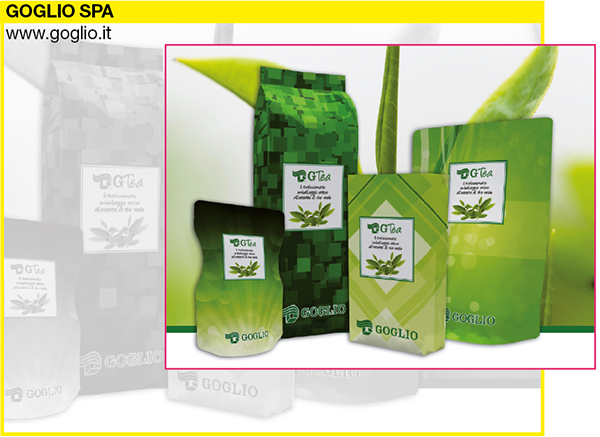

7 Presentorie Selezione Italiana gift box
Made from Favini’s Cartacrusca, the “Selezione Italiana” gift box for Academia Barilla (the brand promoting Italian cuisine around the world) was designed by the DraegerGPP group, which has been producing it since March 2015.
CartaCrusca Favini is the paper made from bran no longer usable for consumption, and DraegerGPP developed the manufacturing process that enables using the 250 g/m2 weight, combined with the “F” wave obtained in line by a corrugator and reels, both in corrugation and on the face. The final result is a single material support that is consistent and pleasant to the touch, with none of the color interference usually occurring with the fiber in full view, and which gives off a light scent of wheat.
CartaCrusca was created in a collaboration between the Barilla group and Cartiera Favini, working side by side to select the most suitable by-product, then to purify and mill it to make it compatible with the paper fiber, to replace up to 20% of virgin tree pulp with bran. The result is a natural-looking paper, the main ingredient of which is plainly visible.
“Selezione Italiana” contains and promotes the Italian culinary tradition with a selection of gastronomic specialties: extra virgin olive oil, Ligurian pesto and a bronze-died box of Barilla pasta.
The DraegerGPP design studio thus had to design a box suitable for containing a variety of products differing by type and size, displaying them in a pleasing arrangement while guaranteeing maximum protection. The box is a veritable “presentoire”, since the lid, once opened and turned over the back, functions as a stand, slightly inclining the box, enhancing the visibility of its contents.
An ochre colored cloth fabric handle echoes the nuance of the logo, further highlighting the design of the entire packaging, an “eco-packaging” solution.
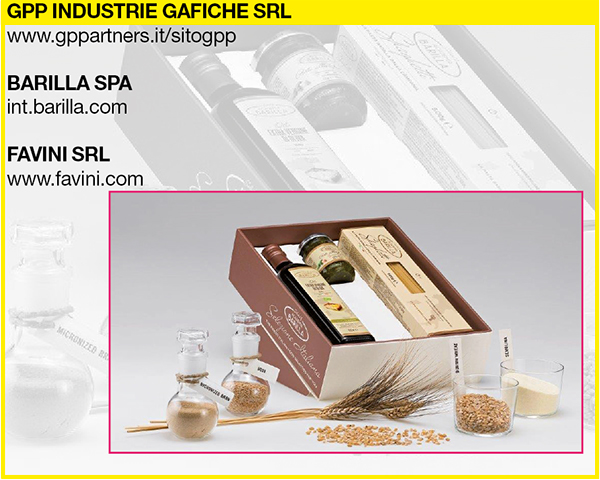

8 Compostable bottle for milk
Ethical and sustainability considerations drive Granarolo’s packaging research. This year, the concern proposes a prototype created with the help of a new technology.
And so the first completely compostable milk bottle is born, made entirely (pre-form, label and closure) using 100% plant-based material from renewable sources rather than fossil plastics.
It’s worth pointing out that the use of plant a material such as Cassava Amara (cultivated in Thailand and China), which is not consumed as food, does not put any extra pressure on the global food system.
And while the bottle and label have been available in PLA for a while already, the real innovation lies in the cap: indeed, its research into PLA from Cassava Amara has enabled Granarolo to identify the most suitable polymer for the production of compression caps.
In this development, what proved decisive was the assistance of Sacmi, which developed the first prototype compression mould for the production of caps, as well as that of Ecobags, a PLA distributor.
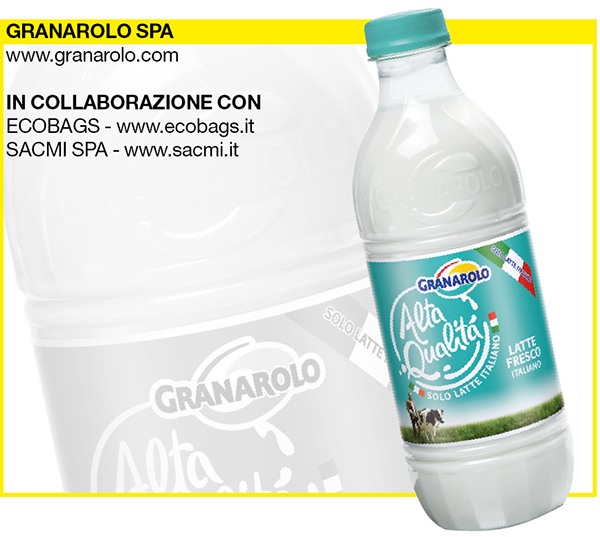

9 Mondaplen® Any Shape Box
Eataly has chosen Mondaplen® Any Shape by Grifal as unique solution for the safe shipping of the infinite combinations of products purchased in its online shop.
A packaging practical and ready to use, it comprises a cardboard box stuffed with strips of Mondaplen®, a patented material with exceptional cushioning performance; extremely soft, it has been designed to adapt to the various shapes and sizes of fragile products.
To effectively defend the contents from shock and vibration, one only need place the packs in the soft padding, which keeps the products in place and separates them during transport, position the protective cover and close the box.
As a further guarantee of safety, Mondaplen® Any Shape Box adopts a tamper evident solution, which reveals any attempts at tampering during transport; in fact, a safety seal is placed on the front closure, while a particular joint prevents the detachment of the rear part of the lid cover without generating visible damage.
Lastly, we reiterate that the packaging is made of 100% recyclable materials and is certified according to ISTA 3A for shipments by majorexpress couriers.
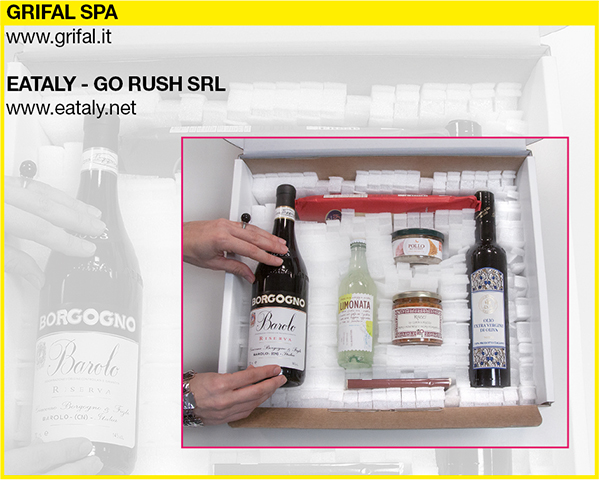

10 Series MU57M3i Infotainment
“Touch me, and I’ll tell you what I hold”: with this claim, Isi Plast presents a new communication tool - a prototype in the advanced stages of development - integrated into its MU57M3i series of industrial containers.
Created with the objective of supplementing conventional advertising tools (packaging design, infographics on the label, etc.), the new tool is a vocal information device to guide the customer’s purchase decision.
An audio reply system was thus inserted into the MU57M3i series containers, one which can be programmed and reactivated at the push of a button, with which it will be possible to record a 4 minute technical-commercial message.
Upon purchase, the customer can activate the audio by pushing a button: a pleasant voice will give explanations and remark the products value, illustrating its quality, advantages, origin and recommended use.
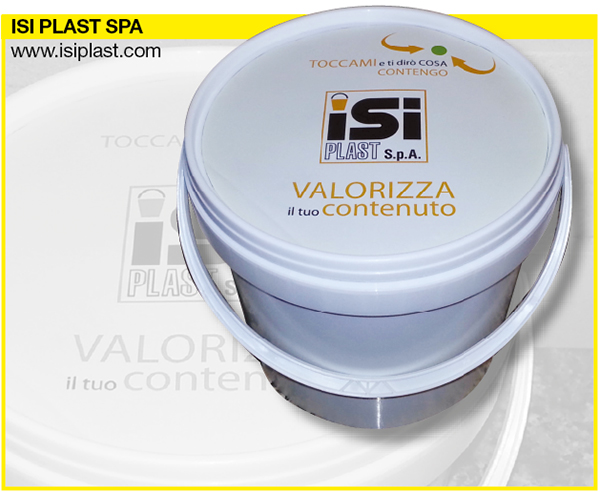

11 DecoType
Aware of the potential and benefits of direct on line digital printing, Krones AG is presenting DecoType: a system of decoration for plastic bottles (but a model for glass is also under development) that meets the requirements of flexibility and decoration associated with the growing product personalisation, the relative reduction lot sizes and the consequent problems of organization and cost effectiveness.
The benefits of the direct printing of containers derive principally from the short creation times, as well as the easy integration of variable data. DecoType has a compact modular design and can print up to a height of 200 mm on empty PET, PP or PE, cylindrical or shaped containers, with excellent aesthetic results Technical characteristics. The printing units integrated with the ink supply and automatic adjustment of the head, enable easy switching from one type of container to another. Even the printhead washing process is automatic. The ink topping-up operation is smooth-running, and the arc lamps ensure safe UV curing.
DecoType also enables the printing of containers with structures difficult to label; thanks to the digital technology, it avoids the production of excess labels, does not require the use of adhesives, reduces storage costs and offers a speedy format change.


12 HT Board
Lic Packaging has developed HT Board, a corrugated cardboard about 750 microns thick, presenting it as an alternative to traditional flat board for packaging, with respect to which it weighs 35-40% less.
A packaging made with HT Board therefore combines the look of a normal coated cardboard printed offset with the advantages of a structure of corrugated cardboard, with benefits all the way down the line for both manufacturer and user. We briefly reiterate them:
- exceptional structural features even with extremely light weights;
- reduction of the weight, waste and saving of raw material;
- freedom and versatility in the choice of the types of paper, depending on the needs of the product to be packed (barrier properties to grease, wet strength, oven friendly containers for conventional cooking or microwave without limitations of time and temperature);
- better thermal conductivity (thanks to the air contained in the waves, which acts as a barrier, the temperature of the frozen products is maintained 5 times better than with flat cardboard packaging);
- industrial packaging processes are simplified, with elimination of primary and/or transport packaging;
- recycling activities are facilitated, since HT Board can be disposed of either with paper or with bio waste.


13 Devin - Crystal Line
The Italian concern P.E.T. Engineering has developed a bottle for Devin, the most well-known mineral water brand in Bulgaria, destined for the launch of the Devin-Crystal Line for the HO.RE.CA. sector. The design challenge at the heart of this endeavor consisted in developing a packaging with premium look using PET rather than glass. This task would require embellishing an economical material through fine design and adequate finishing, in order to combine elegance and refined simplicity with the tested characteristics of robustness, lightness and economy.
Inspired by the geometric and regular shape of crystal, an elegant three-dimensional design runs across the conical bottle, and Novapet’s Glasstar resin, which reproduces the ringing transparency of glass, creates an effect of incessant refraction
The blue and silver label, designed by Design Board International, and the silvery cap accentuate the packaging’s refinement. And while the use of PET instead of glass guarantees a significant reduction in the costs of production, storage and transport, at the same time, the container thusly conceived proves less burdensome on the environment in terms of CO2 emissions, acidification and photochemical oxidation.
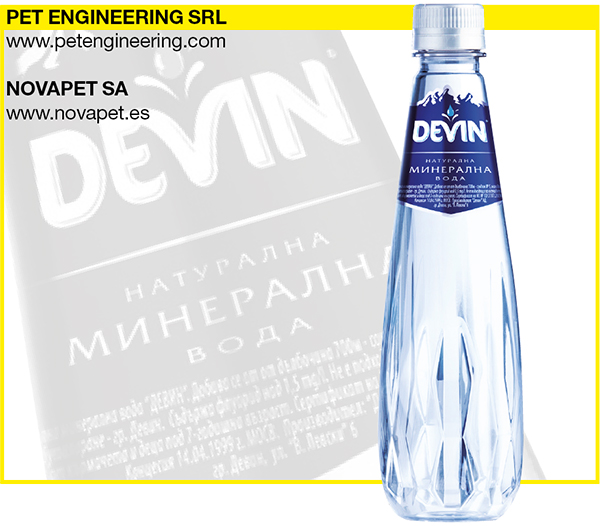

14 Direct Object Printing™
Plastipak Packaging, Inc. developed a new, innovative technology to print a label directly on a plastic bottle: Direct Object Printing™. Plastipak is collaborating with Norda S.p.A. to apply this Plastipak proprietary technology Direct Object Printing™ to their product.
It is a four-color printing process, practically removing the need of a “material” support, therefore reducing scrap and avoiding label obsolescence entirely: a latest generation printing solution, allowing the producer to change easily the label content on PET bottles, able to answer to the market demands faster and more cost effectively.
The color printing process creates opportunities to customize the brand, by providing the freedom to realize any kind of graphical element and speeding up the time to market. Currently, Direct Object Printing™ is the sole technology on the market to offer the possibility to create digital printed labels on both the side and the shoulder of a bottle, or, wraparound, on the entire label area.


15 Wood Effect
For a fresh and natural image at POPs, Polymer Logistics proposes the exclusive Wood Effect re-usable crate.
The advantages of RPCs (reusable plastic crates) are now recognized worldwide: lightweight, hygienic and reclosable, they guarantee a high degree of protection, enable optimizing spaces and require no disposal. It is in this field that Polymer Logistics presents Wood Effect, demonstrating its commitment to innovation: set to revolutionize the image of commercial surfaces dedicated to the sale of fresh products, in particular fresh fruit and vegetables, in addition to its unique and original shape, the crate is equipped with the exclusive Active-Lock opening system, which makes it easier to handle and more ergonomic.
Like all Polymer Logistics products, it is made from completely recyclable virgin polymers and offers the possibility of changing course in terms of in-store marketing and display, adding value to the use of conventional collapsible plastic crates and thus enhancing market feel.
The market has welcomed the potential of the reusable packaging generally and the Wood Effect in particular: by adopting it, a growing number of distributors are enhancing the look of their POP, where a “quaint” fresh produce section represents an evident strength.
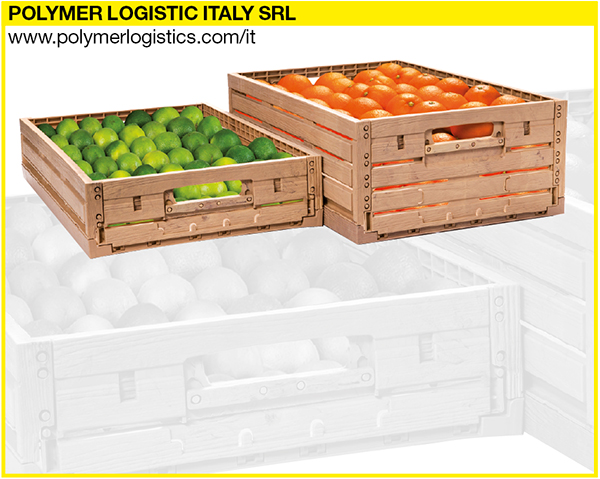

16 A box for Blanc des Millénaires 1995
Pusterla 1880 has executed a packaging concept with a powerful emotive impact for Blanc des Millénaires 1995 de Charles Heidsieck, the Côte des Blancs masterpiece in a legendary vintage.
The secret of this wine lies in its being aged in Gallo-Roman chalk cellars: 30 meters deep, these ancient artificial caves represent a unique site where silence and stillness reign supreme. For a precious white wine boasting numerous gold prizes, Pusterla has thus created an exceptional case: a chest that recalls those chalk cellars, an echo of the nobility of a place where time vanquishes all else.The box was made from a special paper characterized by a texture reminiscent of chalk. The thermoformed container that houses the bottle was designed with an anti-rotation system and a decorative ribbon as a seal to hold the bottle in place.
The engravings on the cover recall the curves of the chalk cellars, and the opening on the front enables a simple an impactful display of the bottle.
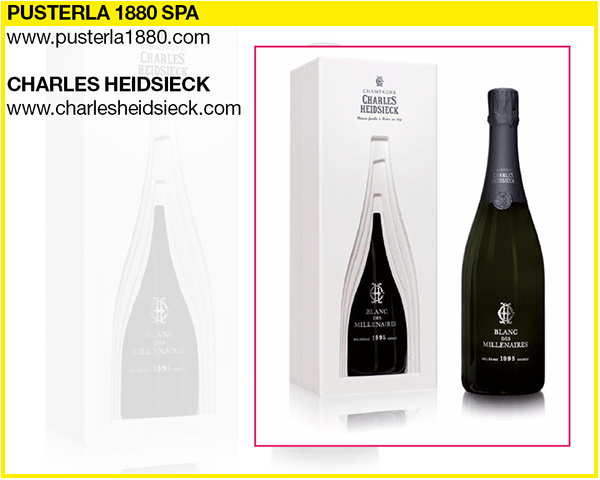

17 Foodsense®
Attention to the smallest ingredients makes for grand quality at the table: the new FOODSENSE® line of food gases and mixtures is conceived and patented by Rivoira for modified atmosphere packaging applications and was developed in order to preserve the sensory attributes typical of a fresh product for the duration of a product’s shelf life, as well as to enable easy detection of micro-leaks in the packaging.
For food products whose sensorial decay outpaces microbiological, chemical/physical and nutritional deterioration, it is important to extend the so-called “sensory shelf-life”, defined as the preservation time during which a food’s sensory characteristics remain unaltered from those set by the producer. It often corresponds in practice to the time in which it is possible to perceive a sensory difference between a preserved and a fresh product.
Protective atmosphere packaging technology represents one of the most valid solutions for preserving long-term the appearance, smell, taste, flavor and consistency of a product, as well as its microbiological and nutritional quality. Its effectiveness in extending sensory shelf life depends on many factors.
In this sense, packaging gases play a decisive role (along with the food product’s intrinsic properties, the environmental conditions of storage and the properties of the packaging materials).
The gaseous mixture introduced during packaging must respond selectively to the preservation needs of each specific food product. Therefore, in order to correctly design a protective atmosphere packaging system capable of preserving the food’s sensory properties, it is indispensable to know both how the gases interact with the food itself and the packaging materials and the effects on the food product and microflora. Authorized packaging gases have different effects on sensory characteristics and are therefore used for different purposes.
In addition to the most commonly used gases (nitrogen, carbon dioxide and oxygen), Rivoira thus proposes the new FOODSENSE® line of food gases and mixtures to preserve the sensory attributes typical of a fresh productas well as to enable easy detection of micro-leaks in the packaging: FOODSENSE® protects color, fragrance and flavor.
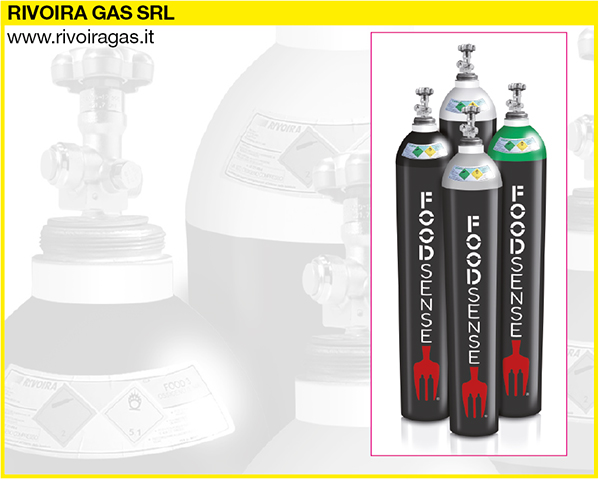

18 Forma Paper
With the registered trademark FORMA PAPER, Sacchital denotes a flexible material in reels, a primarily paper+barrier material laminate destined for the production of thermoformed tubs, capable of extending the shelf life of their contents and easily tailored with rotogravure printing.
The tub can be printed front and back, with multiple register colors (at the moment, the “wood effect” is particularly popular), and thermoforming occurs during the packaging phase in the packaging machine generally employed by the user for plastic tubs, without requiring special modifications to the installation.
After opening, the FORMA PAPER tub with “opaque wood effect” can also be used as a tray for serving right at the dinner table. This material is used to preserve cold cuts and meats, cheeses, fish, fresh pasta and countless other products taking advantage of the image guaranteed by a natural and recyclable support with a striking effect on the eye and to the touch. The predominance of paper, fully FSC certified, makes this solution offered by Sacchital an ecological packaging that can be recycled as paper, according to the Aticelca method.
The FORMA PAPER tub can be combined with a standard transparent plastic lid or a VISTA PAPER lid, which can be customized with a transparent register window, or with the application of adhesive paper.
The FORMA PAPER & VISTA PAPER combo characterizes a product with a strong impact, one that is innovative, perfectly functional and recyclable that jumps out from the shelf.
Both products are registered trademarks of the Sacchital group, as part of its global project PAPERFLEX SYSTEM, which originated with the group’s collaboration with Merano Speck and the need to create an original packaging that guarantees the necessary visibility to a new range of cold cuts.
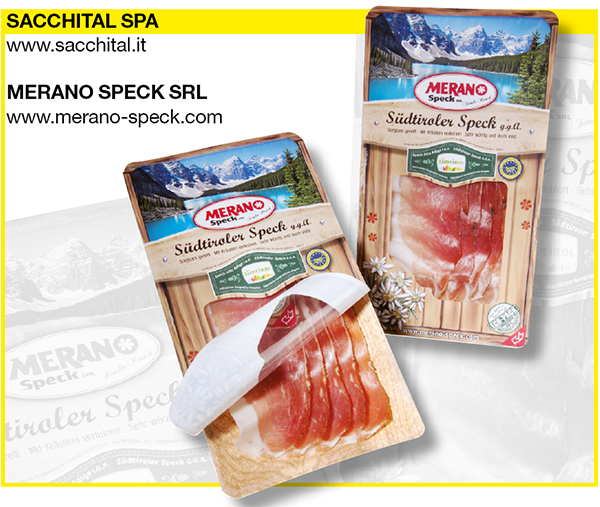

19 Magnum Finale 150 cl
S.Pellegrino presents a new bottle for water destined for the HORECA channel. The design challenge was to create an iconic object capable of highlighting the S.Pellegrino water and its world, accompanying moments of togetherness with excellence, beauty and shared pleasures. For the Magnum S.Pellegrino (350.5 mm tall, 105.5 mm wide and with a 29 mm neck), approximately 1 kg of pure glass was used, embellished with reliefs around the seal and front label.
It contains 1.5 liters of mineral water, the characteristics and quality of which are impeccably preserved by a corona cap (the cap itself and the top of the neck are coated with an aluminium capsule with a safety seal).
The new label is more resistant and the surface treatment highlights the star, the brand’s symbol.
The bottom of the bottle, which recalls champagne bottles, guarantees greater resistance to the pressure of the gas and adorns the product with prestige.
The outcome of this project is the surefire enhancement of the product and brand image, positioning them all the more effectively and expanding its target market: exclusive restaurants, hotel lounges, OOH, wineries… A Magnum that can become an object of exclusive consumption for special events, corporate gift bags, PR events, etc.
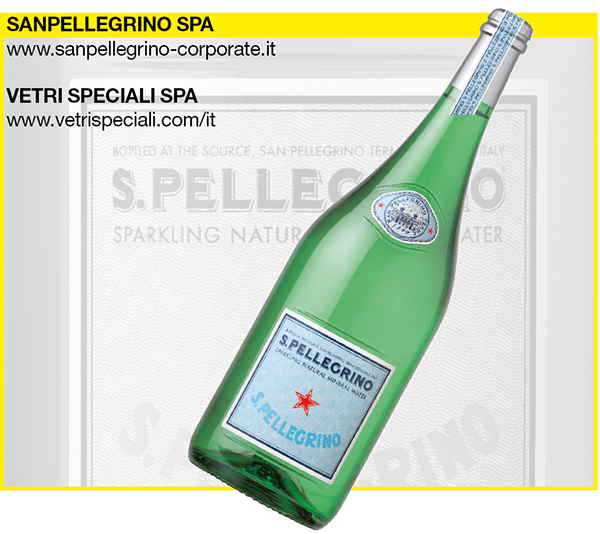

20 Cryovac® Freshness Plus® bag
Product freshness and preservation have always been at the center of research and development operations for the Cryovac® brand.
This is also shown by the new Freshness Plus® line of bags, equipped with an invisible anti-odor layer, integrated into the coextruded multilayer structure with barrier properties. In addition to safeguarding the freshness and flavor of meats and extending their preservation in terms of microbiology, taste and smell, the solution enables enhanced communication (the bag can be printed in 10 colors) and expands service content thanks to the Cryovac® facilitated opening systems Grip & Tear®.
The bag responds in particular to a typical demand of the European poultry market, in which the demand for fresh products translates into a search for high quality, while the needs of consumers and retailers are foiled by the imbalance between supply and demand in the sector of whole chickens. Using Freshness Plus®, the product’s preservation can be extended to up to 11-12 days, with a consequent reduction in yields or waste and incentivizing the consumer to buy larger quantities of fresh meat.In addition to its clear commercial advantages, this system offers shorter slaughtering processes (one full day) and a reduction to energy costs equaling 0.03 Euro/kg, thanks to the transition from freezing to refrigeration. Another point for the product’s sustainability is a 10% reduction in materials thickness. This heatshrink vacuum pack system is also promising for the fresh pork market, with or without bones, facilitating aging. The anti-odor layer enables preventing consumer returns due to odors in the fridge.


21 Packaging for food glazes
Intense flavors in a dense liquid, a fusion of modernity and tradition for Ponti brand glazes (the most famous Italian producer of vinegars, pickles and preserves, condiments and ready sauces).
Ponti quality is made of the finest raw ingredients and technological innovation, and it’s in the latter that Sipa has made a fundamental contribution.
On the market for a few years now, the glazes had been packaged in HDPE bottles, a flexible material processed using a tested technology, but one limited in many ways, especially in relation to achievable shapes, usually cylindrical, with no logos or other detailed shapes.
The new PET version of the packaging, launched in early 2014, proves more elegant, sumptuous and attractive for the consumer, with a transparent material which, unlike HDPE, shows the contents through a brilliant surface. This solution is now used for all five Ponti glazes (balsamic, Moscato must, soy, lemon juice and apple juice). Sipa, riding high on a fruitful collaboration with the Piedmont-based manufacturer (with which it had already developed a 1 liter PET bottle for wine vinegar), was charged with re-designing the product’s packaging to make it more current and ergonomic, easier to handle and more squeezable, a must for facilitating the decoration of dishes. The PET bottles weigh just 14.5 g and contain, according to taste, a quantity of product varying between 145 g and 250 g. Sipa not only supplied Ponti with the machine to blow-mould the container, but also offered a complete packaging development package, producing original plans, renderings and physical prototypes, carrying out product testing and other complementary services. In its labs, the concern performed numerous dimensions checks and tested for mechanical resistance, filling and impacts in the logistics phase. Further testing guaranteed that the bottles maintain their oval shape over time, and, a year later, no perceivable change has been recorded.


22 Tetra Rex®
Tetra Pak®, a global leader in solutions for treating and packaging food products, proposes the first carton for beverages made entirely out of renewable plant-based raw materials. Indeed, the new Tetra Rex®, in addition to cellulose (the primary component), is made up of plant-based polyethylene used both for the film (LDPE) and the caps (HDPE), produced using a sugar cane extract.
Developed in collaboration with Braskem, a major biopolymer producer, the new Tetra Rex will be marketed starting in the early months of 2015. Tetra Pak’s customers that already use the standard 1 liter Tetra Rex with TwistCap OSO 34 can move onto the new version without any additional investment or modifications to existing equipment.
The increase in renewable raw material used in the Tetra Rex, combined with the paper’s FSC™ certification, is not just good for the environment: it also offers an additional competitive advantage to customers by reducing the overall environmental impact of their products.
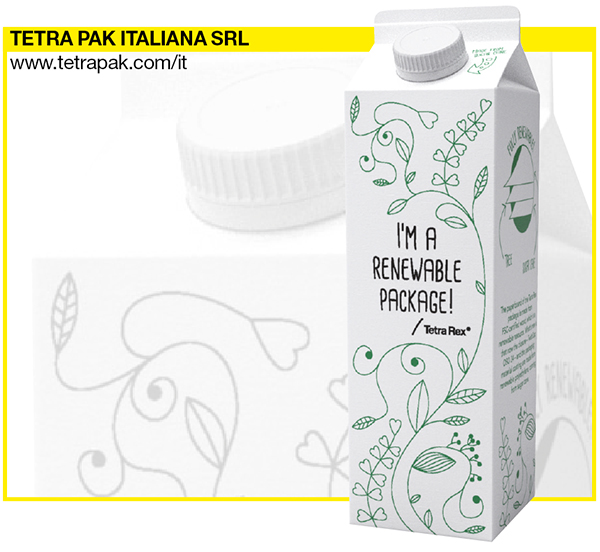

23 Tube with plastic nozzle and soft tip
In the field of tubes with long and thin nozzles, destined for products requiring precision dosing (such as ophthalmic and nasal pharmaceuticals, eyeliner cosmetics, but also glues and products for DIY...), Tubettificio Favia offers an outstanding novelty: an aluminium tube with a plastic nozzle and soft tip.
Until now, Favia offered its customers the conventional aluminium tubes with polyethylene nozzle and safety seal, consisting in a PVC heatshrink sleeve that can be printed in different colors for customization. As opposed to PE nozzle tips, which are rigid, the solution proposed by Favia involves the use of a thermoplastic elastomer, which confers unprecedented flexibility and softness, while maintaining unaltered technical and mechanical properties. In order to further highlight its novelty, the tip can be made in a different color from the base.
The advantages of this solution are clear in all fields of use: for personal care products, this type of nozzle offers the maximum guarantee during application of the product in proximity to delicate body parts like the nose or eyes.
The flexibility of the tip also enables easily reaching the most hidden parts of the objects, in such a way facilitating decoration and DIY activities.


24 Resealable for Stracchino cheese
An idea patented by Smilesys (a manufacturer of resealable facilitated opening packaging systems) updates the packaging for Venchiaredo’s Stracchino cheese by equipping it with a resealable system that offers significant advantages, in terms of both consumption and communication.
The new solution replaces conventional packaging for this product, a PET tub with the fresh cheese inside, enclosed in plastic film overwrapping, finely printed with dedicated graphics.
From a technical standpoint, the resealable packaging adopted by Venchiaredo simplifies consumption, making it no longer necessary to cut open one end and enabling reclosing the wrapping up to 24 times, making possible prolonged storage in the refrigerator.
On the polyester/polyethylene plastic film, which is first printed and die-cut, a label with a pull string is applied to the opening area: one pull is all it takes to open, while keeping the whole thing firmly in one hand, which in such a way becomes a kind of serving dish. In this way, not only does the packaging remain undamaged, but information is also communicated, to the advantage of the product image and its communication potential. With the right modifications and design adjustments on the packaging (like the addition of a spoon/fork), Stracchino cheese could find an outlet in vending machines.


25 GlassCoffee
Verallia puts to use its skills and capacity for innovation to propose GlassCoffee, the first coffee container with a dark glass doser. A complement to the classic “moka” espresso pot - an indispensable object in the Italian kitchen - its brownish red color preserves the taste and aroma of coffee over time.
Produced using a high percentage of recycled glass, this solution is an “eco-restored” and environmentally friendly container, but also one ideal for coffee producers and private labels that can adopt it as a promotional tool and mark of distinction on the shelf.
GlassCoffee is completed with a device made up of a coffee powder dosing mechanism attached to a twist-off capsule that closes the glass jar. Once filled, it is necessary to tightly screw on the cap and turn it over, making it attach to the moka filter (the attachment fits all the most common formats). The dosage mechanism can be used multiple times until the powder fills the filter.
Here is a quick recap of the distinctive features of Verallia’s 2015 proposal:
- GlassCoffee is “light on the environment”, because it is a product made from recycled and 100% infinitely recyclable glass;
- it enticingly displays the contents and can be personalized; it stands out on the shelf and is pleasant to look at during storage and re-use;
- it has the right capacity, 250 g, the exact format for following the market’s standards;
- the design is made highly functional thanks to an innovative design that facilitates dosage into the moka and reduces contact of the coffee with the air.
